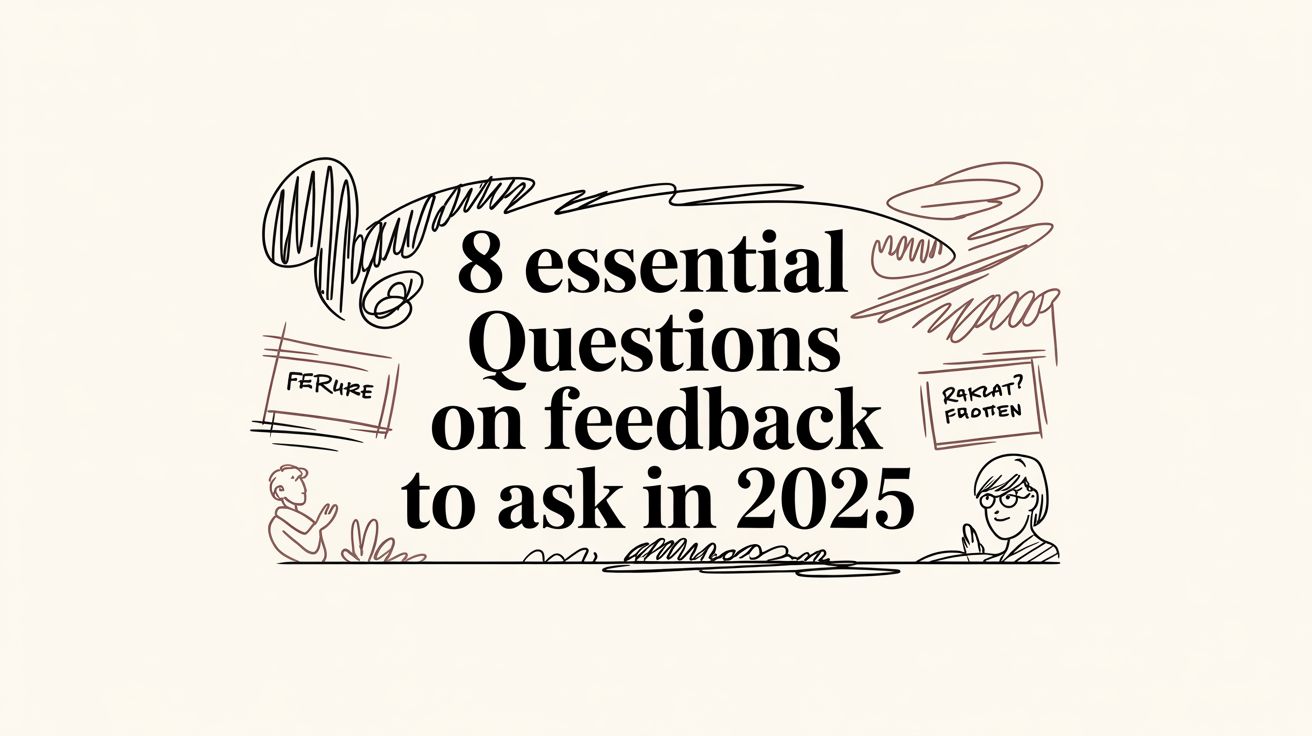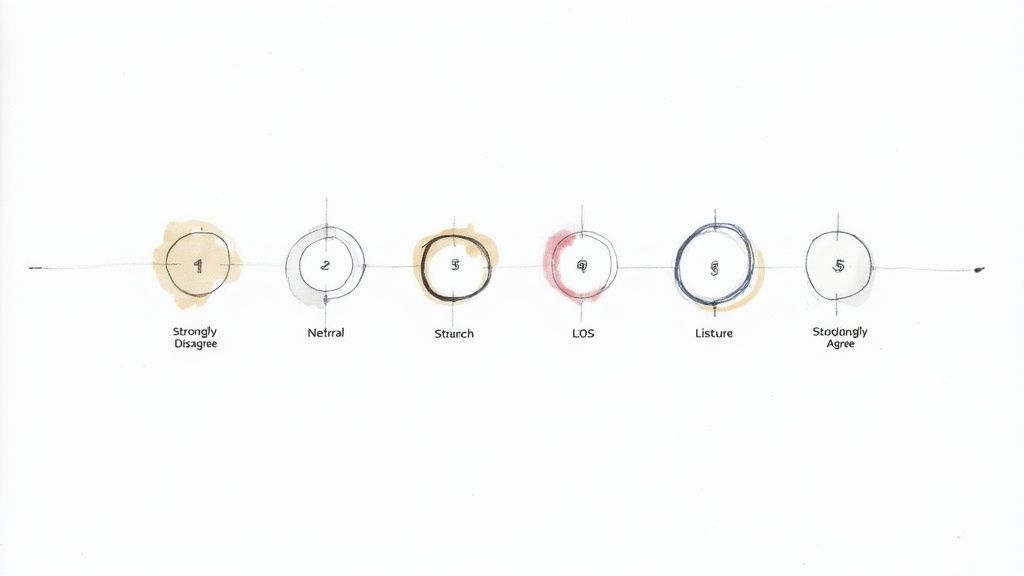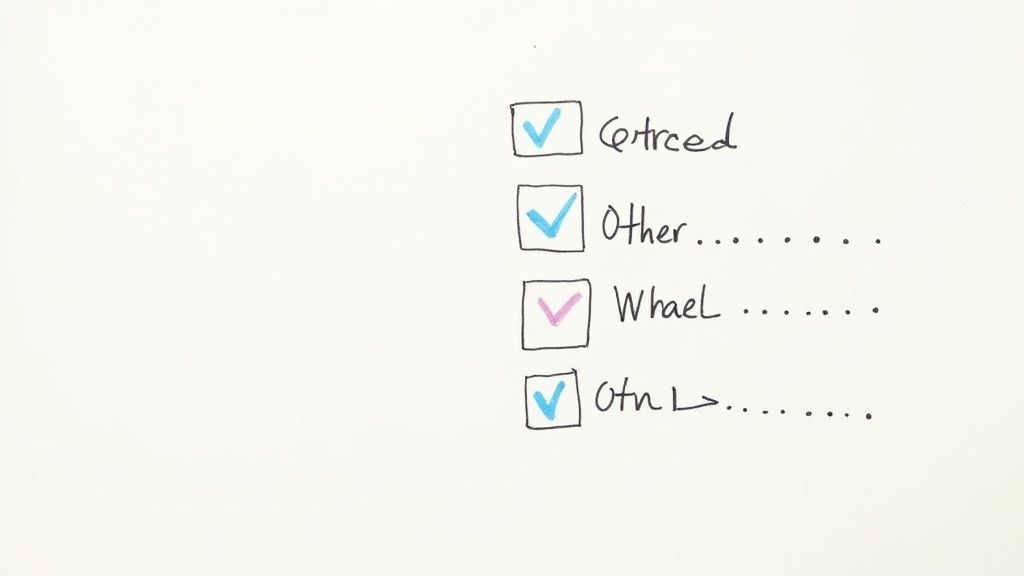8 Essential Questions on Feedback to Ask in 2025

Feedback is the cornerstone of growth, but its value hinges entirely on the quality of the questions you ask. Generic queries like "How was your experience?" often yield generic, unhelpful answers, leaving you with data that lacks direction and offers no clear path for improvement. To truly understand your customers, employees, and market, you must move beyond the obvious and learn to formulate more strategic questions on feedback. This is where the art of inquiry transforms simple data collection into a powerful tool for strategic decision-making.
This comprehensive guide is designed to provide you with a structured toolkit for just that. We will explore 8 powerful types of feedback questions, each engineered to uncover specific, actionable insights for your organisation. From measuring customer loyalty with surgical precision using the Net Promoter Score to unearthing the nuanced "why" behind user behaviour with open-ended follow-ups, mastering these formats is crucial.
By implementing these proven questioning techniques, you can elevate your feedback strategy from a passive pulse-check into an active engine for innovation, service enhancement, and sustainable growth. Let's delve into the frameworks that leading organisations use to gather feedback that genuinely matters, and discover how platforms like GoodKudos can help you implement them seamlessly.
1. The Likert Scale Question
The Likert scale is a cornerstone among questions on feedback, offering a structured way to measure attitudes and opinions quantitatively. It presents a statement or question and asks respondents to indicate their level of agreement, satisfaction, or another sentiment on a symmetrical scale. This method, developed by psychologist Rensis Likert in 1932, translates subjective feelings into analysable data, making it invaluable for businesses of all sizes.

This approach is highly effective for gauging sentiment across large groups quickly. For example, an e-commerce store can use a 5-point scale (1 = Very Dissatisfied to 5 = Very Satisfied) to gather post-purchase feedback, allowing them to calculate an average satisfaction score and spot trends over time. Likewise, a non-profit organisation can use a Likert scale to measure volunteer engagement or donor satisfaction with recent communications.
How to Implement Likert Scale Questions
To leverage the power of this feedback question type, focus on clarity and consistency.
- Use Clear Anchor Labels: Ensure the endpoints of your scale are unambiguous. Phrases like "Strongly Disagree" and "Strongly Agree" or "Not at all Important" and "Extremely Important" work well.
- Maintain Consistency: Use the same scale throughout a single survey. Switching between a 5-point and a 7-point scale can confuse respondents and complicate data analysis.
- Avoid Double-Barrelled Questions: Frame questions to measure a single concept. Instead of "Was our service fast and friendly?", split it into two separate questions to get precise feedback.
Key Insight: The true value of a Likert scale is its ability to benchmark progress. By asking the same questions periodically, you can track shifts in customer satisfaction, employee morale, or product perception, providing clear data to guide your strategy.
For organisations looking to systematise this process, platforms like GoodKudos can help you build, distribute, and analyse feedback surveys that incorporate these powerful questions.
2. The Net Promoter Score (NPS) Question
The Net Promoter Score (NPS) is one of the most powerful and widely adopted questions on feedback, designed to measure customer loyalty with a single, straightforward query. It asks customers, "How likely are you to recommend our company/product/service to a friend or colleague?" on a scale of 0 to 10. This simple question, popularised by Fred Reichheld of Bain & Company, categorises respondents into three distinct groups: Promoters (9-10), Passives (7-8), and Detractors (0-6).
This metric's strength lies in its simplicity and direct correlation with business growth. For example, a SaaS company can track its NPS monthly to gauge customer loyalty after a major feature release, while a financial services firm can benchmark its score against industry averages to understand its competitive position. The final score, calculated by subtracting the percentage of Detractors from the percentage of Promoters, gives a clear indicator ranging from -100 to +100.
How to Implement NPS Questions
Effectively using the NPS question involves more than just asking it; it requires a systematic approach to analysis and action.
- Always Ask a Follow-Up Question: Immediately after the rating, ask an open-ended question like, "What is the primary reason for your score?". This qualitative data provides the crucial context needed to understand what drives loyalty or dissatisfaction.
- Track Trends Consistently: Measure your NPS at regular intervals, such as monthly or quarterly. This allows you to monitor the impact of changes you make and identify long-term trends in customer sentiment.
- Segment Your Data: Analyse NPS results by different customer cohorts, such as new customers versus long-term clients, or by region or product line. This segmentation can reveal specific areas of strength and opportunities for improvement.
Key Insight: The NPS is not just a score to be reported; it is a system for organisational improvement. By sharing the results and feedback across all departments, from marketing to product development, you create a customer-centric culture focused on turning Detractors into Promoters.
To efficiently manage your NPS surveys and analyse the results, platforms like GoodKudos provide the tools to collect, track, and act on this vital customer feedback.
3. The Open-Ended Question
The open-ended question is a powerful tool among questions on feedback, inviting respondents to share their thoughts in their own words without predefined answers. Unlike structured formats, questions like "What could we improve?" or "Tell us about your experience" generate rich, qualitative data full of context, emotion, and specific details that closed-ended questions simply cannot capture.
This approach is invaluable for uncovering the "why" behind customer or employee behaviour. For instance, a small business could use an open-ended question in an exit interview like, "What prompted your decision to leave?", to gain deep insights into its company culture. Similarly, an e-commerce brand could ask, "What is one feature you wish our product had?", to gather innovative ideas directly from its most engaged users, driving a user-centric product development roadmap.
How to Implement Open-Ended Questions
To get the most out of this feedback question type, you need a strategy for both asking and analysing.
- Place Them Strategically: Position open-ended questions after closed-ended ones. This warms up the respondent and prevents the initial, more demanding question from causing them to abandon the survey.
- Keep Language Simple and Unbiased: Phrase questions clearly and avoid jargon. A question like "What did you think of the onboarding process?" is much more effective than "How would you evaluate the efficacy of our client integration protocol?".
- Balance with Quantitative Data: Use open-ended questions to add depth to quantitative results. Combining a low Net Promoter Score with a follow-up question like, "What was the primary reason for your score?", provides a complete picture.
Key Insight: The real power of open-ended questions lies in their ability to reveal unforeseen issues and opportunities. While structured questions confirm hypotheses, unstructured feedback uncovers the "unknown unknowns" that can lead to genuine breakthroughs in service, product, or process.
Organisations aiming to effectively gather and analyse this type of qualitative feedback can use platforms like GoodKudos to integrate open-ended questions into their surveys and make sense of the valuable insights they provide.
4. The Multiple Choice Question
The multiple choice question is a versatile tool among questions on feedback, providing respondents with a predefined set of answers. This format guides users toward specific options, making it an excellent method for collecting structured, quantitative data that is easy to categorise and analyse. It strikes a balance between the simplicity of a yes/no question and the detail of an open-ended one, allowing for more nuanced insights without overwhelming the respondent.

This approach is perfect for segmenting your audience or pinpointing specific issues. For example, an e-commerce brand could ask, "What prevented you from completing your purchase?" with options like "High shipping costs," "Complicated checkout process," or "Concern about security." Similarly, a non-profit could use it to discover where its supporters heard about them, helping to focus future marketing efforts on the most effective channels.
How to Implement Multiple Choice Questions
To create effective multiple choice questions, your options must be clear, comprehensive, and well-organised.
- Keep Options Concise: Limit the number of choices to between 5 and 7 to prevent choice overload. Too many options can lead to respondent fatigue and poor-quality data.
- Include an 'Other' Option: Always provide an escape hatch like an "Other (please specify)" or "Not applicable" choice. This captures responses you may not have anticipated and ensures every respondent can answer accurately.
- Ensure Options are Mutually Exclusive: For single-answer questions, make sure the choices do not overlap. If multiple answers are possible, instruct respondents to "Select all that apply."
Key Insight: Multiple choice questions are powerful because they direct focus. By carefully curating the answer options, you can guide respondents to consider specific aspects of their experience, leading to more actionable and easily quantifiable feedback.
For businesses looking to implement targeted feedback forms, platforms like GoodKudos simplify the creation and analysis of surveys featuring robust multiple choice questions.
5. The Ranking/Rating Question
The Ranking/Rating question is a powerful comparative tool that moves beyond isolated opinions to reveal relative priorities. It asks respondents to arrange a list of items in order of preference, importance, or frequency, or to assign individual ratings to multiple related items. This method is exceptionally useful for understanding what truly matters most to your audience within a specific context.
This approach is ideal for forcing trade-offs and identifying top priorities. For instance, a small business could ask customers to rank potential new services, providing clear guidance on where to invest resources. Similarly, a charity could use this type of question to ask donors to rate the importance of various programme areas, helping to shape fundraising campaigns and communications. It uncovers not just what people like, but what they value most compared to other options.
How to Implement Ranking/Rating Questions
To get the most out of these comparative questions on feedback, focus on a clear and user-friendly design.
- Limit the List: To avoid overwhelming respondents, keep ranking lists concise, ideally between 5 and 10 items. For longer lists, consider a rating scale instead.
- Use an Intuitive Interface: For online surveys, a 'drag and drop' functionality offers a much better user experience for ranking tasks than asking users to manually type numbers.
- Randomise Item Order: Present the items in a random order for each respondent. This helps to reduce order bias, where items appearing at the top of the list are given more attention.
- Provide Clear Instructions: Clearly explain the criteria for ranking or rating. For example, specify whether respondents should rank based on "importance," "preference," or "frequency of use."
Key Insight: Ranking questions are invaluable for strategic decision-making. They provide an explicit hierarchy of needs or desires, offering a clear roadmap for product development, service improvements, or budget allocation that aligns directly with stakeholder priorities.
Organisations wanting to prioritise features or initiatives can use platforms like GoodKudos to create intuitive ranking and rating questions, turning audience feedback into a clear, actionable plan.
6. The Behavioral/Behavioral Intention Question
While opinions are valuable, observed actions often tell a more accurate story. Behavioral and behavioral intention questions on feedback move beyond sentiment to ask respondents about what they actually do or plan to do. This approach provides a powerful predictor of future outcomes, as it grounds feedback in tangible actions rather than abstract feelings. Popularised by behavioural economists, this method reveals true priorities and is crucial for forecasting customer loyalty and engagement.
This type of question is highly effective for measuring real-world impact. For instance, a small charity can ask donors, "Have you recommended our cause to a friend in the past 6 months?" to gauge genuine advocacy. Similarly, an online course creator could ask, "How many modules have you completed in the last 30 days?" to understand actual product usage, which is a far more reliable metric for retention than a simple satisfaction score.
How to Implement Behavioral/Behavioral Intention Questions
To effectively use these questions, precision and context are key. Focus on getting clear, actionable data about user habits.
- Specify a Clear Timeframe: Vague questions yield vague answers. Instead of "Do you use this feature?", ask, "How frequently did you use this feature in the last 30 days?" (e.g., daily, weekly, rarely).
- Use Concrete Frequency Categories: Offer clear, distinct options like "Once a day," "2-3 times a week," or "Once a month" to avoid ambiguity and simplify analysis.
- Ask a Follow-up "Why": After a behavioral question like "Will you renew your subscription?", add an open-ended question such as "What is the primary reason for your decision?" to uncover the drivers behind the action.
Key Insight: The real strength of behavioural questions is their ability to bridge the gap between what people say and what they do. By tracking these metrics over time, you can validate whether new features or service improvements are genuinely changing user behaviour, providing concrete evidence of your strategy's success.
For organisations aiming to integrate these predictive questions into their feedback strategy, a platform like GoodKudos can help you design surveys that measure both attitudes and actions, providing a complete picture of customer engagement.
7. The Comparative/Benchmark Question
The comparative or benchmark question moves beyond internal metrics to contextualise your performance within the broader market. It asks respondents to directly compare your product, service, or organisation against specific competitors, alternatives, or their previous solutions. This type of feedback question is crucial for understanding your competitive positioning and identifying your unique value proposition from the customer's perspective.
This approach delivers powerful insights that absolute ratings cannot. For instance, a small agency might discover that while their project management is rated 4 out of 5, clients perceive it as significantly more organised than their previous freelance providers. Similarly, an e-commerce brand could learn that customers chose them over a major competitor due to their personalised customer service, even if their prices are slightly higher. This reveals not just what you do well, but where you have a decisive advantage.
How to Implement Comparative/Benchmark Questions
To get the most out of these strategic questions on feedback, precision and focus are essential.
- Specify Competitors: When possible, name specific competitors. Instead of a vague "How do we compare to others?", ask, "How does our platform's user interface compare to Salesforce?"
- Focus on Key Criteria: Ask respondents what specific factors drove their comparison. A follow-up question like, "What was the most important difference in your comparison?" can uncover critical details about price, features, or support.
- Segment Your Analysis: Analyse responses based on the competitor mentioned. Understanding why you win against Competitor A versus Competitor B allows for highly targeted marketing and product development strategies.
- Update Your List: Markets change quickly. Regularly review and update the list of competitors you include in your surveys to ensure they remain relevant to your customers.
Key Insight: Comparative questions transform feedback from a simple performance report into a strategic intelligence tool. They clarify why customers choose you over others, providing a clear roadmap for marketing messages, sales pitches, and service improvements that highlight your competitive strengths.
To effectively gather and analyse this type of competitive data, tools like GoodKudos can help you design targeted surveys and segment feedback to reveal your true market position.
8. The Follow-Up 'Why' Question
While quantitative ratings provide a snapshot of sentiment, the follow-up ‘why’ question transforms surface-level data into deep, actionable insight. This probing question asks respondents to explain the reasoning behind their previous answer, uncovering the root causes, drivers, and context that numbers alone cannot reveal. It is one of the most powerful questions on feedback for understanding the customer experience.

This approach adds a qualitative layer to quantitative feedback, making it indispensable for any organisation. For instance, after a customer gives a Net Promoter Score (NPS), asking, "What is the primary reason for your score?" can reveal specific product features they love or service issues that need immediate attention. Similarly, a charity asking a donor, "What factors most influenced your decision to give?" can gather valuable information to refine its fundraising campaigns and communications.
How to Implement Follow-Up 'Why' Questions
To effectively use this question type, focus on timing, simplicity, and analysis.
- Position It Immediately: Ask your 'why' question directly after the rating question it relates to. This captures the respondent's reasoning while it is still fresh in their mind.
- Keep the Prompt Simple: Use clear and neutral language. Simple prompts like "Could you tell us a bit more about why you chose that score?" are more effective than complex or leading questions.
- Use Conditional Logic: To avoid survey fatigue, use logic to show the 'why' question only to specific segments. For example, you might only ask for reasons from detractors (low scores) or promoters (high scores) to focus your analysis.
- Analyse for Themes: Manually or with software, code open-ended responses into recurring themes. Identifying patterns like "slow delivery" or "helpful support staff" allows you to quantify qualitative feedback and prioritise improvements.
Key Insight: The follow-up 'why' question is your direct line to the voice of the customer. It moves you beyond knowing what they think to understanding why they think it, providing the specific details needed to make meaningful changes to your products, services, or processes.
For businesses and non-profits aiming to capture and analyse this crucial qualitative data, platforms like GoodKudos offer tools to seamlessly integrate these questions into your feedback strategy.
8 Key Feedback Question Types Compared
| Question Type | 🔄 Implementation Complexity | ⚡ Resource Requirements / Efficiency | 📊 Expected Outcomes | 💡 Ideal Use Cases | ⭐ Key Advantages |
|---|---|---|---|---|---|
| The Likert Scale Question | Low — standardized design, low cognitive load | Low — minimal tooling; easy automation | Consistent quantitative scores; trend analysis | Large-scale satisfaction tracking, benchmarking | High comparability and easy analysis |
| The Net Promoter Score (NPS) Question | Low — single-question format, simple scoring | Very low — quick to deploy, low survey fatigue | Single loyalty metric (-100 to +100); benchmarkable | Customer loyalty programs, competitor benchmarking | Predictive of growth; industry standard |
| The Open-Ended Question | High — unstructured responses require coding/interpretation 🔄 | High — manual coding or NLP tools and analyst time | Rich qualitative insights; context, sentiment, quotes | Exploratory research, root-cause discovery, testimonials | Deep, unexpected insights and verbatim evidence |
| The Multiple Choice Question | Low — predefined options, straightforward logic | Low — easy to collect and quantify efficiently | Clear categorical results; simple aggregation | Feature usage, demographics, channel/source tracking | Fast for respondents; reduces ambiguity |
| The Ranking/Rating Question | Moderate — comparative design; UX matters | Moderate — design and more complex analysis | Reveals priorities and relative importance; hierarchies 📊 | Feature prioritization, resource allocation, trade-offs | Shows clear priorities for decision-making |
| The Behavioral / Behavioral Intention Question | Low–Moderate — requires precise timeframe and wording | Low–Moderate — benefits from linking to usage data | Predictive indicators of actual or intended actions | Forecasting, retention planning, usage measurement | More predictive of outcomes; easier to validate |
| The Comparative / Benchmark Question | Moderate — needs competitor context and framing | Moderate — requires segmentation and competitor lists | Relative positioning; competitive gaps and strengths 📊 | Market positioning, pricing strategy, win/loss analysis | Clarifies competitive advantages and weaknesses |
| The Follow-Up "Why" Question | Moderate — conditional logic and probing phrasing | Moderate–High — analysis of open responses required | Actionable root-cause insights that explain scores 📊 | Immediately after ratings (NPS/Likert) to uncover drivers | Transforms quantitative scores into specific actions |
Turn Questions into Action and Amplify Your Success
Throughout this guide, we've explored a powerful arsenal of questions designed to elicit meaningful feedback. We've journeyed from the quantitative precision of Likert Scales and Net Promoter Scores to the rich, narrative depth of open-ended and follow-up 'Why' questions. Each format, from multiple-choice to behavioural intention queries, serves a distinct and vital purpose in painting a complete picture of your audience's experience.
The central takeaway is that a truly effective feedback strategy is never one-dimensional. It is a carefully orchestrated blend of different question types, each building upon the other. A high NPS score is encouraging, but understanding the 'why' behind that score is where true innovation begins. A multiple-choice selection reveals a preference, but a follow-up ranking question can clarify its priority. This strategic layering is what transforms raw data into a directional compass for your organisation.
From Insights to Impact: Your Actionable Roadmap
Mastering the art of asking the right questions on feedback is the foundational step. The next, equally crucial phase, is turning those answers into tangible improvements and strategic assets. Your path forward involves three key commitments:
- Implement a Balanced Approach: Don't rely solely on one type of question. Review your current feedback mechanisms, such as surveys, review requests, and customer interviews. Are you balancing quantitative scales with qualitative, open-ended opportunities? Aim to create a system where you capture both the what and the why.
- Analyse and Synthesise: Collecting feedback is only half the battle. Dedicate time to analyse the responses, looking for recurring themes, patterns, and actionable suggestions. Connect the dots between different feedback channels. For instance, do the insights from your customer service follow-up questions align with the pain points mentioned in your product improvement surveys?
- Make Feedback Visible: The most powerful feedback often comes in the form of glowing testimonials and user stories. This social proof is an invaluable marketing asset. Don't let it sit unseen in a spreadsheet or inbox. The final step is to showcase this hard-earned trust to build credibility, attract new customers, and celebrate the positive impact your work is having.
By embracing this holistic process, you move beyond simply collecting data. You begin a continuous, dynamic conversation with your audience. This dialogue fuels smarter product development, refines your service delivery, and ultimately builds stronger, more loyal relationships. The power is not just in the questions themselves, but in the commitment to listen, learn, and act on the answers you receive.
Ready to effortlessly collect and display the powerful testimonials your new feedback questions will generate? Create a free Kudos Wall with Good Kudos and start turning your happiest customers' feedback into your most compelling marketing asset. Visit Good Kudos to get started in seconds.
